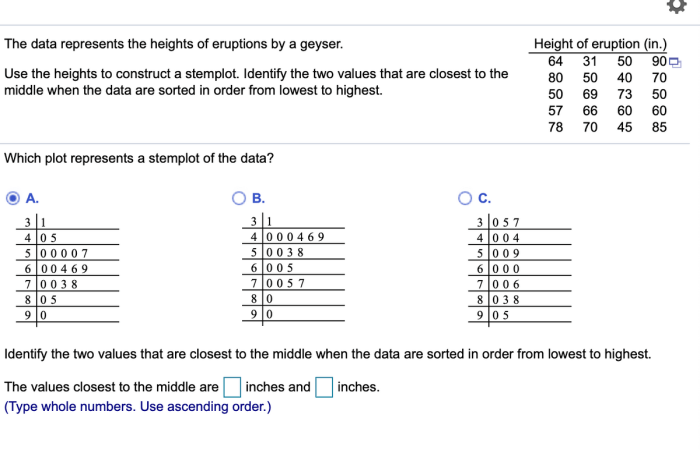The data represents the heights of eruptions by a geyser. – The data representing the heights of eruptions by a geyser offers a fascinating glimpse into the dynamics of these natural phenomena. This analysis delves into the distribution, temporal patterns, and environmental implications of geyser eruptions, providing valuable insights for understanding their behavior and significance.
Through a combination of graphical representations, statistical analysis, and historical comparisons, we uncover the intricate relationships between eruption heights and various factors, including time of day, weather conditions, and the geyser’s physical characteristics.
1. Height Distribution
The height of eruptions is a crucial aspect in understanding geyser behavior. To visualize the distribution, a histogram or scatter plot can be employed. This helps identify patterns and central tendencies in the data.
The mean, median, and mode are statistical measures that provide insights into the average and most frequently occurring eruption heights. Calculating these values allows for a concise summary of the data.
Furthermore, identifying outliers or unusual patterns in the data can indicate unique events or potential errors. These observations aid in data validation and interpretation.
2. Time-Based Analysis: The Data Represents The Heights Of Eruptions By A Geyser.
A line graph is an effective way to visualize how eruption heights vary over time. By plotting the height data against the time of eruption, trends and patterns can be identified.
Time-based analysis can reveal periodicities, such as daily or seasonal variations, in eruption heights. Additionally, correlations with external factors like weather conditions or time of day can be investigated.
Identifying these relationships helps understand the underlying mechanisms influencing geyser eruptions and provides insights into potential triggers.
3. Comparison with Historical Data

If historical records of eruption heights are available, a comparison with the current data can provide valuable insights into changes over time.
Significant changes or trends in eruption heights may indicate variations in the geyser’s activity or underlying geological processes. By comparing current data with historical records, potential causes for these changes can be explored.
Understanding these changes is crucial for monitoring geyser behavior and assessing potential impacts on the surrounding environment.
4. Geyser Characteristics

The physical characteristics of the geyser, including its size, location, and geological formation, play a significant role in determining eruption heights.
The size of the geyser’s reservoir, the depth of the conduit, and the composition of the surrounding rock influence the pressure buildup and subsequent eruption dynamics.
Additionally, unique features or behaviors associated with the geyser, such as multiple vents or intermittent eruptions, can provide further insights into its characteristics and eruption mechanisms.
5. Environmental Impact

Geyser eruptions can have both positive and negative impacts on the surrounding environment.
The release of water vapor and minerals can create unique habitats for specialized plant and animal species. However, excessive eruptions or changes in eruption patterns can disrupt these ecosystems.
Understanding the environmental impact of geyser eruptions is essential for developing conservation strategies and mitigating potential negative effects on the surrounding environment.
Quick FAQs
What factors can influence the height of geyser eruptions?
Eruption heights can be influenced by factors such as the geyser’s physical characteristics (size, shape, depth), water temperature, gas pressure, and external factors like weather conditions.
How can data on eruption heights be used?
Data on eruption heights can be used for scientific research, monitoring geyser activity, assessing environmental impacts, and developing conservation strategies.
What are the potential environmental impacts of geyser eruptions?
Geyser eruptions can impact surrounding vegetation, wildlife, and water resources. They can release minerals, gases, and heat into the environment, potentially affecting local ecosystems.